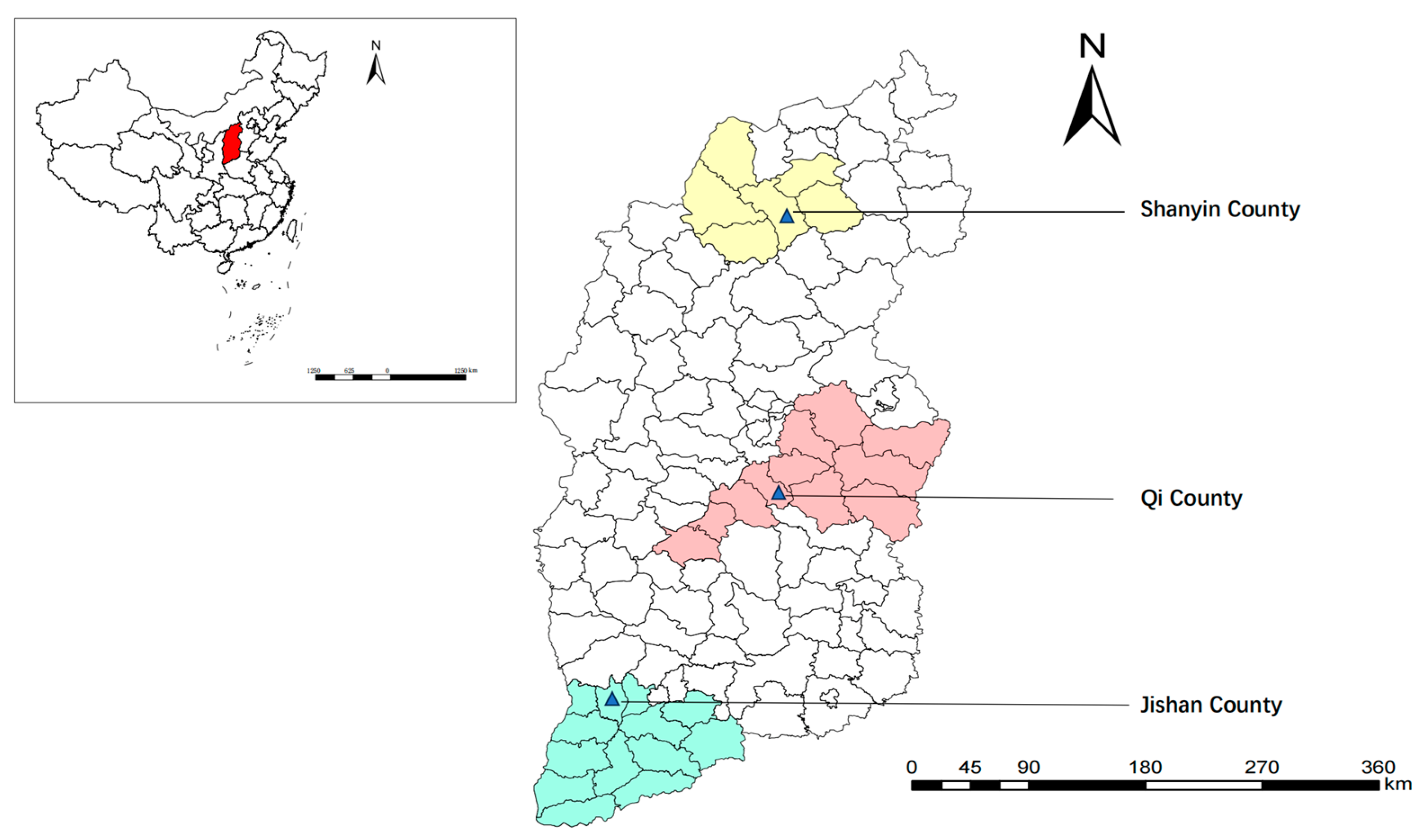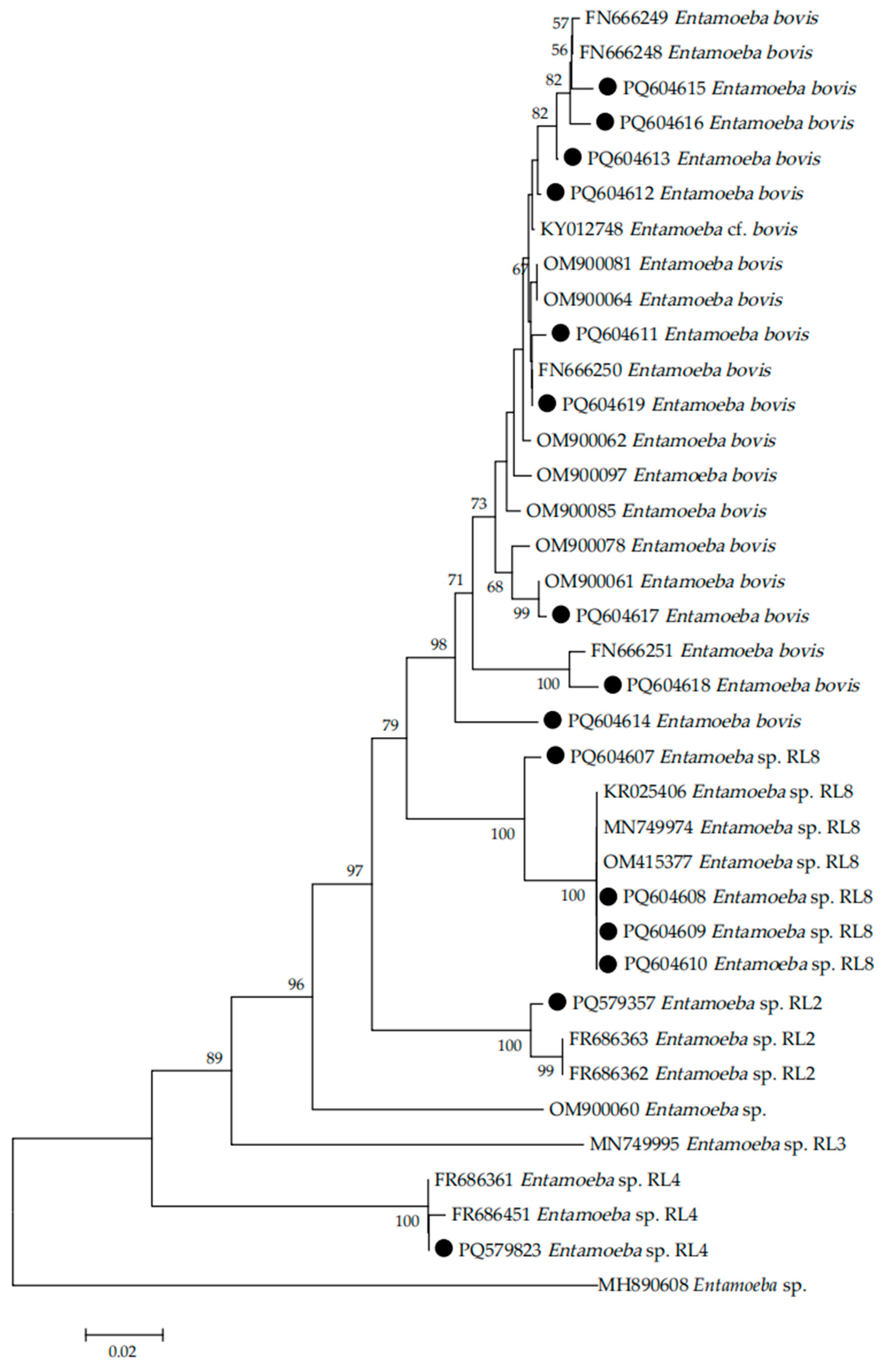First Molecular Identification of Entamoeba spp. in Sheep, Beef Cattle, and Dairy Cattle in Shanxi Province, North China
Simple Summary
Abstract
1. Introduction
2. Materials and Methods
2.1. Sample Collection
2.2. DNA Extraction and PCR Amplification
2.3. Sequence and Phylogenetic Analyses
2.4. Statistical Analysis
3. Results
3.1. Prevalence of Entamoeba spp. in Sheep
3.2. Prevalence of Entamoeba spp. in Dairy Cattle
3.3. Prevalence of Entamoeba spp. in Beef Cattle
3.4. Sequence Alignment and Phylogenetic Analysis of Entamoeba
4. Discussion
5. Conclusions
Author Contributions
Funding
Institutional Review Board Statement
Informed Consent Statement
Data Availability Statement
Conflicts of Interest
References
- Carrero, J.C.; Reyes-López, M.; Serrano-Luna, J.; Shibayama, M.; Unzueta, J.; León-Sicairos, N.; Garza, M. Intestinal amoebiasis: 160 years of its first detection and still remains as a health problem in developing countries. Int. J. Med. Microbiol. 2020, 310, 151358. [Google Scholar] [CrossRef] [PubMed]
- Morf, L.; Singh, U. Entamoeba histolytica: A snapshot of current research and methods for genetic analysis. Curr. Opin. Microbiol. 2012, 15, 469–475. [Google Scholar] [CrossRef] [PubMed]
- Fotedar, R.; Stark, D.; Beebe, N.; Marriott, D.; Ellis, J.; Harkness, J. Laboratory diagnostic techniques for Entamoeba species. Clin. Microbiol. Rev. 2007, 20, 511–532. [Google Scholar] [CrossRef] [PubMed]
- Manna, D.; Ehrenkaufer, G.M.; Lozano-Amado, D.; Singh, U. Entamoeba stage conversion: Progress and new insights. Curr. Opin. Microbiol. 2020, 58, 62–68. [Google Scholar] [CrossRef]
- Guillén, N. Pathogenicity and virulence of Entamoeba histolytica, the agent of amoebiasis. Virulence 2023, 14, 2158656. [Google Scholar] [CrossRef]
- Showler, A.J.; Boggild, A.K. Entamoeba histolytica . CMAJ 2013, 185, 1064. [Google Scholar] [CrossRef]
- Morán, P.; Serrano-Vázquez, A.; Rojas-Velázquez, L.; González, E.; Pérez-Juárez, H.; Hernández, E.G.; Padilla, M.L.A.; Zaragoza, M.E.; Portillo-Bobadilla, T.; Ramiro, M.; et al. Amoebiasis: Advances in diagnosis, treatment, immunology features and the interaction with the intestinal ecosystem. Int. J. Mol. Sci. 2023, 24, 11755. [Google Scholar] [CrossRef]
- Stanley, S.L. Amoebiasis. Lancet 2003, 361, 1025–1034. [Google Scholar] [CrossRef]
- Marie, C.; Petri, W.A. Regulation of virulence of Entamoeba histolytica. Annu. Rev. Microbiol. 2014, 68, 493–520. [Google Scholar] [CrossRef]
- Rojas, L.; Morán, P.; Valadez, A.; Gómez, A.; González, E.; Hernández, E.; Partida, O.; Nieves, M.; Gudiño, M.; Magaña, U.; et al. Entamoeba histolytica and Entamoeba dispar infection in Mexican school children: Genotyping and phylogenetic relationship. BMC Infect. Dis. 2016, 16, 485. [Google Scholar] [CrossRef]
- Nakada-Tsukui, K.; Nozaki, T. Immune response of Amebiasis and immune evasion by Entamoeba histolytica. Front. Immunol. 2016, 7, 175. [Google Scholar] [CrossRef] [PubMed]
- Ali, I.K.; Clark, C.G.; Petri, W.A. Molecular epidemiology of amebiasis. Infect. Genet. Evol. 2008, 8, 698–707. [Google Scholar] [CrossRef] [PubMed]
- Wang, P.; Li, S.; Zou, Y.; Han, R.Y.; Wang, P.; Song, D.P.; Wang, C.B.; Chen, X.Q. Molecular characterization of Entamoeba spp. in pigs with diarrhea in southern China. Animals 2022, 12, 1476. [Google Scholar] [CrossRef]
- Gao, W.W.; Ma, Y.T.; Ma, Y.Y.; Li, R.L.; Li, J.; Zheng, F.G.; Zheng, W.B.; Liu, Q.; Zhu, X.Q. First report of Eimeria and Entamoeba infection in alpacas (Vicugna pacos) in Shanxi Province, northern China. Parasitol. Res. 2021, 120, 2031–2035. [Google Scholar] [CrossRef]
- Stensvold, C.R.; Berg, R.; Maloney, J.G.; Molokin, A.; Santin, M. Molecular characterization of Blastocystis and Entamoeba of muskoxen and sheep in Greenland. Int. J. Parasitol. 2023, 53, 673–685. [Google Scholar] [CrossRef]
- Matsubayashi, M.; Matsuura, Y.; Nukata, S.; Daizi, Y.; Shibahara, T.; Teramoto, I.; Matsuo, T.; Uni, S.; Hatta, T.; Kaneko, A.; et al. First detection and molecular identification of Entamoeba bovis from Japanese cattle. Parasitol. Res. 2018, 117, 339–432. [Google Scholar] [CrossRef]
- Aryal, M.; Adhikari, R.B.; Kandel, P.; Ghimire, T.R.; Khadka, D.; Maharjan, J.; Gaire, K.P.; Shrestha, S.; Manandhar, K.D.; Kandel, R.C.; et al. First report on the molecular detection of Entamoeba bovis from the endangered wild water buffalo (Bubalus arnee) in Nepal. Vet. Med. Sci. 2022, 8, 799–807. [Google Scholar] [CrossRef]
- Huaman, J.L.; Pacioni, C.; Kenchington-Evans, L.; Doyle, M.; Helbig, K.J.; Carvalho, T.G. First evidence of Entamoeba parasites in Australian wild deer and assessment of transmission to cattle. Front. Cell Infect. Microbiol. 2022, 12, 883031. [Google Scholar] [CrossRef]
- Stensvold, C.R.; Lebbad, M.; Victory, E.L.; Verweij, J.J.; Tannich, E.; Alfellani, M.; Legarraga, P.; Clark, C.G. Increased sampling reveals novel lineages of Entamoeba: Consequences of genetic diversity and host specificity for taxonomy and molecular detection. Protist 2011, 162, 525–541. [Google Scholar] [CrossRef]
- Verweij, J.J.; Laeijendecker, D.; Brienen, E.A.; Lieshout, L.; Polderman, A.M. Detection and identification of Entamoeba species in stool samples by a reverse line hybridization assay. J. Clin. Microbiol. 2003, 41, 5041–5045. [Google Scholar] [CrossRef]
- Liang, Y.; Liu, Y.Y.; Mei, J.J.; Zheng, W.B.; Liu, Q.; Gao, W.W.; Zhu, X.Q.; Xie, S.C. Molecular identification and genotyping of Cryptosporidium spp. and Blastocystis sp. in cattle in representative areas of Shanxi province, north China. Animals 2023, 13, 2929. [Google Scholar] [CrossRef] [PubMed]
- Qin, R.L.; Liu, Y.Y.; Mei, J.J.; Zou, Y.; Zhang, Z.H.; Zheng, W.B.; Liu, Q.; Gao, W.W.; Xie, S.C.; Zhu, X.Q. Molecular identification and genotyping of Enterocytozoon bieneusi in sheep in Shanxi province, north China. Animals 2022, 12, 993. [Google Scholar] [CrossRef] [PubMed]
- Ai, S.; Zhang, Z.; Wang, X.; Zhang, Q.; Yin, W.; Duan, Z. The first survey and molecular identification of Entamoeba spp. in farm animals on Qinghai-Tibetan Plateau of China. Comp. Immunol. Microbiol. Infect. Dis. 2021, 75, 101607. [Google Scholar] [CrossRef]
- Al-Habsi, K.; Yang, R.; Ryan, U.; Jacobson, C.; Miller, D.W. Morphological and molecular characterization of an uninucleated cyst-producing Entamoeba spp. in captured Rangeland goats in Western Australia. Vet. Parasitol. 2017, 235, 41–46. [Google Scholar] [CrossRef]
- Liu, X.C.; Ren, Q.; Guo, J.; Chen, D.Q.; Li, Q.Q.; Luo, X.Y.; Gu, Y.F.; Li, W.C. First detection and molecular identification of Entamoeba bovis in farm-raised Sika deer from Anhui province, China. Acta Parasitol. 2022, 67, 1782–1787. [Google Scholar] [CrossRef]
- Ren, M.; Yang, F.; Gou, J.M.; Wang, P.X.; Zou, M.; Zhong, X.H.; Lin, Q. First detection and molecular identification of Entamoeba in yaks from China. Acta Parasitol. 2021, 66, 264–270. [Google Scholar] [CrossRef]
- Kang, Y.; Lu, X.S.; He, Y.H.; Wang, C.; Wu, Z.X.; Wang, L.; Wu, X.J.; Hu, J.J.; Zhu, X.Q. First molecular identification and prevalence of Sarcocystis spp. in sheep intended for human consumption in Shanxi province, China. Vet. Sci. 2024, 11, 504. [Google Scholar] [CrossRef]
- Souza, J.B.; Silva, Z.A.; Alves-Ribeiro, B.S.; Moraes, I.S.; Alves-Sobrinho, A.V.; Saturnino, K.C.; Ferraz, H.T.; Machado, M.F.; Braga, Í.A.; Ramos, D.S. Prevalence of intestinal parasites, risk factors and zoonotic aspects in dog and cat populations from Goiás, Brazil. Vet. Sci. 2023, 10, 492. [Google Scholar] [CrossRef]
- Jacob, A.S.; Busby, E.J.; Levy, A.D.; Komm, N.; Clark, C.G. Expanding the Entamoeba universe: New hosts yield novel ribosomal lineages. J. Eukaryot. Microbiol. 2016, 63, 69–78. [Google Scholar] [CrossRef]
- Clark, C.G.; Kaffashian, F.; Tawari, B.; Windsor, J.J.; Twigg-Flesner, A.; Davies-Morel, M.G.; Blessmann, J.; Ebert, F.; Peschel, B.; Van, A.L.; et al. New insights into the phylogeny of Entamoeba species provided by analysis of four new small-subunit rRNA genes. Int. J. Syst. Evol. Microbiol. 2006, 56, 2235–2239. [Google Scholar] [CrossRef]
- Stensvold, C.R.; Lebbad, M.; Clark, C.G. Genetic characterisation of uninucleated cyst-producing Entamoeba spp. from ruminants. Int. J. Parasitol. 2010, 40, 775–778. [Google Scholar] [CrossRef] [PubMed]
- Al-Dabbagh, S.K.; Alseady, H.H.; Alhadad, E.J. Molecular identification of Entamoeba spp. in humans and cattle in Baghdad, Iraq. Vet. World 2024, 17, 1348–1355. [Google Scholar] [CrossRef]


| Factor | Category (County) | No. Tested | No. Positive | Prevalence % (95% CI) | Odds Ratio (95% CI) | p-Value |
|---|---|---|---|---|---|---|
| Region | Shanyin | 108 | 43 | 39.8 (30.6–49.0) | 1 | <0.001 |
| Qi | 97 | 70 | 72.2 (63.2–81.1) | 3.9 (2.2–7.1) | ||
| Jishan | 106 | 47 | 44.3 (34.9–53.8) | 1.2 (0.7–2.1) | ||
| Age | M > 6 | 241 | 107 | 44.4 (38.1–50.7) | 1 | <0.001 |
| M ≤ 6 | 70 | 53 | 75.7 (65.7–85.8) | 3.9 (2.1–7.1) | ||
| Total | 311 | 160 | 51.5 (45.9–57.0) |
| Factor | Category (County) | No. Tested | No. Positive | Prevalence % (95% CI) | Odds Ratio (95% CI) | p-Value |
|---|---|---|---|---|---|---|
| Region | Shanyin | 206 | 156 | 75.7 (69.9–81.6) | 1 | <0.001 |
| Qi | 137 | 122 | 89.1 (83.8–94.3) | 2.6 (1.4–4.9) | ||
| Jishan | 49 | 47 | 95.9 (90.4–100.0) | 7.5 (1.8–32.1) | ||
| Sex | Male | 68 | 57 | 83.8 (75.1–92.6) | 1.1 (0.5–2.2) | 0.825 |
| Female | 324 | 268 | 82.7 (78.6–86.8) | 1 | ||
| Age | M > 18 | 216 | 180 | 83.3 (78.4–88.3) | 1.1 (0.6–1.8) | 0.804 |
| M ≤ 18 | 176 | 145 | 82.4 (76.8–88.0) | 1 | ||
| Total | 392 | 325 | 82.9 (79.2–86.6) |
| Factor | Category (County) | No. Tested | No. Positive | Prevalence % (95% CI) | Odds Ratio (95% CI) | p-Value |
|---|---|---|---|---|---|---|
| Region | Qi | 174 | 123 | 70.7 (63.9–77.5) | 1 | <0.001 |
| Jishan | 219 | 188 | 85.8 (81.2–90.5) | 2.5 (1.5–4.2) | ||
| Sex | Male | 185 | 151 | 81.6 (76.0–87.2) | 1.3 (0.8–2.1) | 0.253 |
| Female | 208 | 160 | 76.9 (71.2–82.6) | 1 | ||
| Age | M > 12 | 96 | 68 | 70.8 (61.7–79.9) | 1.9 (1.1–3.1) | 0.021 |
| M ≤ 12 | 297 | 243 | 81.8 (77.4–86.2) | 1 | ||
| Total | 393 | 311 | 79.1 (75.1–83.2) |
Disclaimer/Publisher’s Note: The statements, opinions and data contained in all publications are solely those of the individual author(s) and contributor(s) and not of MDPI and/or the editor(s). MDPI and/or the editor(s) disclaim responsibility for any injury to people or property resulting from any ideas, methods, instructions or products referred to in the content. |
© 2025 by the authors. Licensee MDPI, Basel, Switzerland. This article is an open access article distributed under the terms and conditions of the Creative Commons Attribution (CC BY) license (https://creativecommons.org/licenses/by/4.0/).
Share and Cite
Wu, Z.-X.; Xiao, H.-D.; He, Y.-H.; Huang, S.-B.; Li, J.; Kang, Y.; Zheng, W.-B.; Zhu, X.-Q. First Molecular Identification of Entamoeba spp. in Sheep, Beef Cattle, and Dairy Cattle in Shanxi Province, North China. Vet. Sci. 2025, 12, 19. https://doi.org/10.3390/vetsci12010019
Wu Z-X, Xiao H-D, He Y-H, Huang S-B, Li J, Kang Y, Zheng W-B, Zhu X-Q. First Molecular Identification of Entamoeba spp. in Sheep, Beef Cattle, and Dairy Cattle in Shanxi Province, North China. Veterinary Sciences. 2025; 12(1):19. https://doi.org/10.3390/vetsci12010019
Chicago/Turabian StyleWu, Ze-Xuan, Han-Dan Xiao, Yuan-Hui He, Shi-Bo Huang, Jing Li, Yu Kang, Wen-Bin Zheng, and Xing-Quan Zhu. 2025. "First Molecular Identification of Entamoeba spp. in Sheep, Beef Cattle, and Dairy Cattle in Shanxi Province, North China" Veterinary Sciences 12, no. 1: 19. https://doi.org/10.3390/vetsci12010019
APA StyleWu, Z.-X., Xiao, H.-D., He, Y.-H., Huang, S.-B., Li, J., Kang, Y., Zheng, W.-B., & Zhu, X.-Q. (2025). First Molecular Identification of Entamoeba spp. in Sheep, Beef Cattle, and Dairy Cattle in Shanxi Province, North China. Veterinary Sciences, 12(1), 19. https://doi.org/10.3390/vetsci12010019







